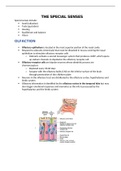Summary
Summary The Special Senses review
- Institution
- Memorial University Of Newfoundland (MUNSU )
An easy-to-follow complete review of the special senses. Explains each concept in detail, step-by-step. This review guide will help you focus on what is important to learn for midterm and final exams.
[Show more]



